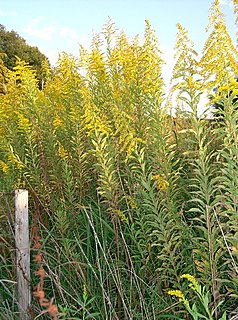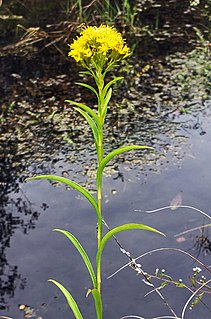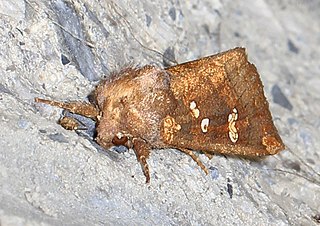
Solidago, commonly called goldenrods, is a genus of about 100 to 120 species of flowering plants in the family Asteraceae. Most are herbaceous perennial species found in open areas such as meadows, prairies, and savannas. They are mostly native to North America, including Mexico; a few species are native to South America and Eurasia. Some American species have also been introduced into Europe and other parts of the world.

Salvinorins are a group of natural chemical compounds and their structural analogs. Several salvinorins have been isolated from Salvia divinorum. They are classified as diterpenoid furanolactones. Salvinorin A is a hallucinogen with dissociative effects.

Solidago canadensis, known as Canada goldenrod or Canadian goldenrod, is an herbaceous perennial plant of the family Asteraceae. It is native to northeastern and north-central North America and often forms colonies of upright growing plants, with many small yellow flowers in a branching inflorescence held above the foliage. It is an invasive plant in other parts of the continent and several areas worldwide, including Europe and Asia. It is grown as an ornamental in flower gardens.

Solidago shortii, commonly known as Short's goldenrod, is a species of goldenrod in the family Asteraceae. The only known populations of Short's goldenrod occur around the Blue Licks Battlefield State Park area of Kentucky and Harrison-Crawford State Forest in Indiana. It was listed on the Federal Register of Endangered Species on September 5, 1985, and was given a global rank of G1 on February 29, 2000.
Clerodane diterpenes, sometimes referred to as clerodane diterpenoids, are a large group of secondary metabolites that have been isolated from several hundreds of different plant species, as well as fungi, bacteria and marine sponges. They are bicyclic terpenes that contain 20 carbons and a decalin core.

Solidago sempervirens, the seaside goldenrod or salt-marsh goldenrod, is a plant species in the genus Solidago of the family Asteraceae. It is native to eastern North America and parts of the Caribbean. It is an introduced species in the Great Lakes region. Similar plants found in the Azores are thought have evolved from a natural introduction of this species.

Solidago nemoralis is a species of flowering plant in the family Asteraceae. It is native to North America, where it is widely found in Canada and the United States. Its common names include gray goldenrod, gray-stem goldenrod, old-field goldenrod, field goldenrod, prairie goldenrod, dwarf goldenrod, and dyersweed goldenrod.

Solidago rugosa, commonly called the wrinkleleaf goldenrod or rough-stemmed goldenrod, is a species of flowering plant in the family Asteraceae. It is native to North America, where it is widespread across eastern and central Canada and the eastern and central United States. It is usually found in wet to mesic habitats.

Solidago altissima, the tall goldenrod or late goldenrod, is a North American species of goldenrod widespread across much of Canada, the United States, and northern Mexico. It is common in much of its range, and fairly tolerant of landscapes which have been disturbed by humans. It has become naturalized in many parts of the world.

Solidago gigantea is a North American plant species in the family Asteraceae. Its common names include tall goldenrod and giant goldenrod, among others.
The molecular formula C25H36O5 may refer to:

Gigactonine is a naturally occurring diterpene alkaloid first isolated from Aconitum gigas. It occurs widely in the Ranunculaceae plant family. The polycyclic ring system of this chemical compound contains nineteen carbon atoms and one nitrogen atom, which is the same as in aconitine and this is reflected in its preferred IUPAC name.

Solidago ptarmicoides, the prairie goldenrod, white flat-top goldenrod or upland white aster, is a North American perennial flowering plant in the family Asteraceae. It is native to the central and eastern Canada and parts of the United States (mostly Great Lakes region, the Northeast, the Ozarks, and the northern Great Plains, with isolated populations in Wyoming, Colorado, Oklahoma, and scattered locations in the Southeast. It has also been called upland white solidago, upland white goldenrod, and sneezewort goldenrod

Solidago riddellii, known as Riddell's goldenrod, is a North American plant species in the genus Solidago of the family Asteraceae. It grows primarily in the Great Lakes and eastern Great Plains of Canada and the United States. It is sometimes considered part of the genus Oligoneuron, but as a Solidago, included in the section Solidago sect. Ptarmicoidei, the flat-topped goldenrods.

Solidago rigida, known by the common names stiff goldenrod and stiff-leaved goldenrod, is a North American plant species in the family Asteraceae. It has a widespread distribution in Canada and the United States, where it is found primarily east of the Rocky Mountains. It is typically found in open, dry areas associated with calcareous or sandy soil. Habitats include prairies, savannas, and glades.

Solidago latissimifolia, common name Elliott's goldenrod, is North American species of flowering plants in the family Asteraceae. It is native to the Atlantic Coast of the United States and Canada, from Nova Scotia south to Alabama and Florida.

The goldenrod gall fly, also known as the goldenrod ball gallmaker, is a species of fly native to North America. The species is best known for the characteristic galls it forms on several species in the Solidago, or goldenrod, genus. The fly's eggs are inserted near the developing buds of the plant. After hatching, the larvae migrate to an area below the plant's developing buds, where they then induce the plant's tissues to form into the hardened, bulbous chamber referred to as a gall. E. solidaginis’s interactions with its host plant(s) and insect, as well as avian, predators have made it the centerpiece of much ecological and evolutionary biology research, and its tolerance of freezing temperatures has inspired studies into the anti-freeze properties of its biochemistry.

Papaipema duovata, the seaside goldenrod stem borer or seaside goldenrod borer, is a moth that is native to North America, where it is found in the coastal plain from the gulf coast north to at least New Jersey. The species is listed as threatened in Connecticut. It was described by Henry Bird in 1902.
John Cameron Semple is a botanist, cytotaxonomist, professor emeritus, and adjunct professor at the University of Waterloo in Ontario, Canada. He was born in Boston and earned a degree of Bachelor of Science in 1969 from Tufts University, followed in 1971 and 1972 by Master of Arts and Doctor of Philosophy degrees from Washington University in St. Louis. Semple is known for his work with members of the tribe Astereae, particularly goldenrods, American asters, and goldenasters, and he maintains the University of Waterloo Astereae Lab website. Semple's wife is Brenda, and in 2013, he named a newly-discovered goldenrod species Solidago brendiae in honor of her.



















